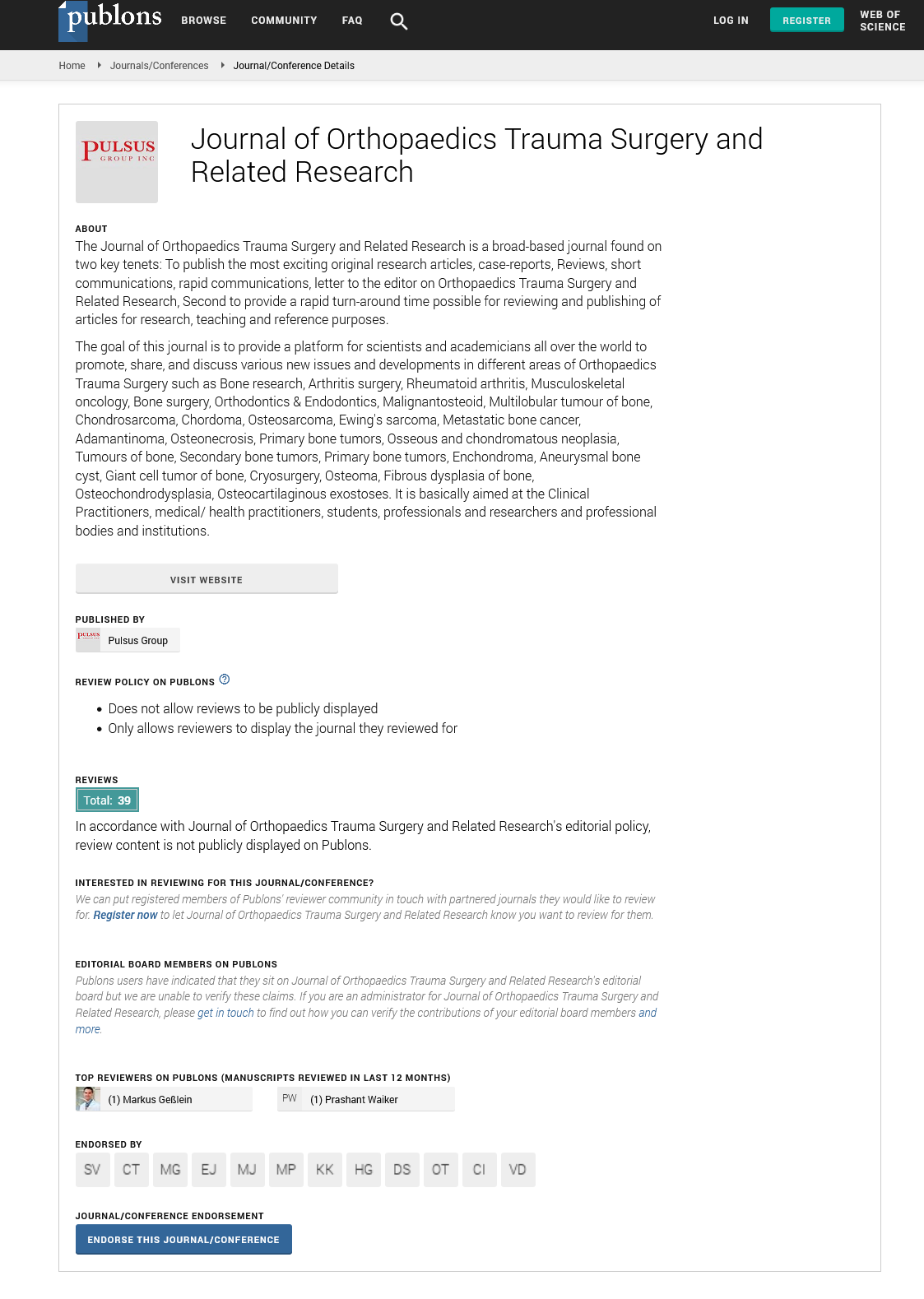Chronic Refractory Tendinopathy
Received: 12-Nov-2021 Accepted Date: Nov 18, 2021 ; Published: 23-Nov-2021, DOI: 10.37532/1897-2276.2021.16(1).50
This open-access article is distributed under the terms of the Creative Commons Attribution Non-Commercial License (CC BY-NC) (http://creativecommons.org/licenses/by-nc/4.0/), which permits reuse, distribution and reproduction of the article, provided that the original work is properly cited and the reuse is restricted to noncommercial purposes. For commercial reuse, contact reprints@pulsus.com
Abstract
Over 30 million doctor visits are attributed to chronic refractory tendinopathy each year (2013). Despite the significant burden of sickness caused by this syndrome, there is no unanimity on treatment or even what constitutes a chronic refractory state. The notion of a chronic refractory process has been refined by recent research. More importantly, a revolutionary new technique looks to offer a potential treatment for the majority of patients at all anatomic locations of involvement. In over 70,000 treatments over the last 6 years, the use of an ultrasonic device directed to diseased tissue under ultrasound picture guidance has proven to be extremely safe and effective. As more clinical trials become available, documented experience suggests that this treatment is conducted with the same difficulty and safety as a cortisone injection, but without the cost or morbidity of surgery.
https://aermech.com https://world-oceans.org https://lline.net https://apecu.org https://febayder.com https://johnbirch.org
Introduction
The Mayo Clinic has published a study that revealed the previously unknown fact that symptoms of lateral epicondylitis last for 6 months in roughly 20% of individuals. Furthermore, the mean time to resolution was an additional 24 months in the 20% of patients who were still enduring pain. These findings led the researchers to define chronic refractory epicondylitis as a disease that lasts longer than 6 months despite receiving proper treatment. In addition, an examination of the ICD codes used in the United States in 2013 revealed that over 30 million people were diagnosed with chronic tendinopathy or fasciitis. While the disease has a large impact, there is a lot of disagreement in the research on the best way to manage chronic refractory conditions.
Since 2012, a unique strategy to treating this problem has been offered in the form of a percutaneous ultrasonic treatment. While ultrasonic or extracorporeal therapy platforms have been used in the past, widespread popularity has been limited due to costs, pain, unexpected outcomes, problems, and a lengthy recovery period. The extraordinary success of ultrasonic treatment for cataracts for more than 20 years prompted researchers to try using the same strategy for tendonopathy. The device and technique are both important aspects of this technology.
A hollow probe the size of an 18 gauge needle delivers ultrasonic energy. Because the probe is hollow, suction can be used to remove the tissue that has been sliced by the ultrasonic energy. Continuous irrigation through a sleeve that surrounds the probe is a third crucial component. The energy’s precise intensity has been shown to eliminate degenerative tissue while having no effect on normal tendon. For more tough and comprehensive diseases, treatment using ultrasonic energy released by depressing a peddle ranges from 60-90 seconds to 3-5 minutes. When a characteristic hypoechoic lesion is present, the signal in the sick tendon changes immediately, becoming normoechoic. If this happens, it means the area has been properly treated. The procedure has been quickly adopted and accepted since its introduction. Recent studies on chronic tendonopathy have not only recognized this approach’s success, but have even labelled it the “treatment of choice” for this ailment. More failures will be discovered as clinical experience grows. However, more experience will help define the sensitivity of the results to factors such as selection, technique, preoperative issues like steroid injections, worker’s compensation, and prior surgery, and postoperative treatment, such as the need for and value of adjunctive therapy, walking boot, and other similar devices.
Patients who have had symptoms for six months or longer despite previous treatments are candidates for decisive intervention. This therapy method gives definite treatment without the cost or morbidity of surgery, but with the intricacy of a steroid injection and the effectiveness of surgery. This level of efficacy, together with the low risk profile, suggests that this could be the therapy platform of the future for this disease.



 Journal of Orthopaedics Trauma Surgery and Related Research a publication of Polish Society, is a peer-reviewed online journal with quaterly print on demand compilation of issues published.
Journal of Orthopaedics Trauma Surgery and Related Research a publication of Polish Society, is a peer-reviewed online journal with quaterly print on demand compilation of issues published.